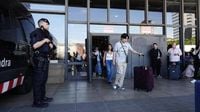On April 28, 2025, a massive power outage struck Spain, leaving millions in darkness and disrupting public transport across the country, particularly in Barcelona. The blackout, which began around 12:33 PM, led to significant chaos as thousands of commuters found themselves trapped in trains and metro stations, with emergency services scrambling to evacuate passengers.
In Barcelona, the Sants station remained open overnight to assist those affected by the outage. Thousands of users were evacuated from trains and the metro, with many relying on the light from their mobile phones to navigate through the darkened tunnels. Marina, a student at the University of Barcelona, described her ordeal: "I was on my way to Sant Celoni when the train stopped between Sants and Passeig de Gràcia. We were stuck in the dark for about an hour and a half before police arrived to help us walk along the tracks to safety."
With the Cercanías service suspended and only bus services operational, long queues formed at bus stops as people attempted to leave the city. Jessica, another commuter, expressed her frustration after waiting for a bus to Castelldefels for over half an hour, contemplating taking a taxi but lacking cash. Manuel, who also faced difficulties, borrowed money from a friend to pay for a bus to Salou.
The impact of the blackout was felt across the entire state, with 116 trains affected and more than 30,000 passengers needing evacuation. Minister of Transport Óscar Puente announced that train services for medium and long distances were not expected to resume that day. He stated, "It's not foreseeable that train circulation will be restored today," as authorities worked to manage the crisis.
As night fell, the situation remained tense. The government advised people to limit travel as the country faced critical hours. President Pedro Sánchez urged citizens to stay informed through official channels and to avoid spreading unverified information. He activated the crisis committee to address the emergency and convened the National Security Council to assess the situation.
By 6:00 AM on April 29, 2025, nearly 99% of electrical demand had been restored, but not without complications. The blackout had left many urban areas without street lighting, creating hazardous conditions. In Madrid, residents celebrated the return of power with applause and car horns as electricity gradually returned to various neighborhoods.
In the aftermath of the outage, the government announced that tickets for the entire Renfe Cercanías network would be free on April 29, 2025, as a gesture to assist stranded passengers. The Barcelona City Council also opened several sports centers to accommodate those who could not return home due to the disrupted train services.
As the situation improved, public transport in Barcelona began to recover. By late afternoon, the metro service had resumed on lines L1, L5, L9, and L10, with partial service restored on lines L3 and L4. However, many lines remained non-operational, and the city continued to face traffic congestion due to non-functioning traffic lights.
Traffic jams reached 17 kilometers on the B-10, 11 kilometers on the B-23, and nearly 8 kilometers on the B-20 as commuters sought alternative routes. The Catalan Traffic Service reported significant delays, complicating the movement of vehicles throughout the city.
In addition to transport disruptions, the blackout affected water supply in high-altitude areas managed by Agbar, which serves over a million homes and businesses in Catalonia and the Balearic Islands. The company warned that if the power outage persisted, water supply issues could escalate.
As emergency services worked to restore order, firefighters in Barcelona responded to 388 incidents related to the blackout, primarily rescuing individuals trapped in elevators. The situation was chaotic, with many businesses forced to close due to the lack of power, while others adapted by using manual tools and cash transactions.
In hospitals, emergency power generators ensured that critical medical services remained operational. The Ministry of Health reported no serious incidents due to the outage, although some scheduled surgeries and appointments were canceled.
As the crisis unfolded, speculation about the cause of the blackout arose, with theories ranging from a cyberattack to a technical failure. President Sánchez stated that the sudden loss of 15 gigawatts of power, constituting 60% of the electrical supply, was under investigation, with all possibilities being explored.
In the days following the outage, residents expressed their relief as normalcy began to return. Many reflected on the fear and uncertainty experienced during the blackout, drawing parallels to previous crises such as the pandemic. Antonia, a woman who had been separated from her family during the outage, finally regained contact and was able to return home, relieved that everyone was safe.
As Spain slowly recovered from this unprecedented event, the government vowed to investigate the causes thoroughly and ensure that measures are put in place to prevent future occurrences. The resilience of the citizens was evident as they navigated the challenges, demonstrating solidarity and support for one another amid the chaos.


